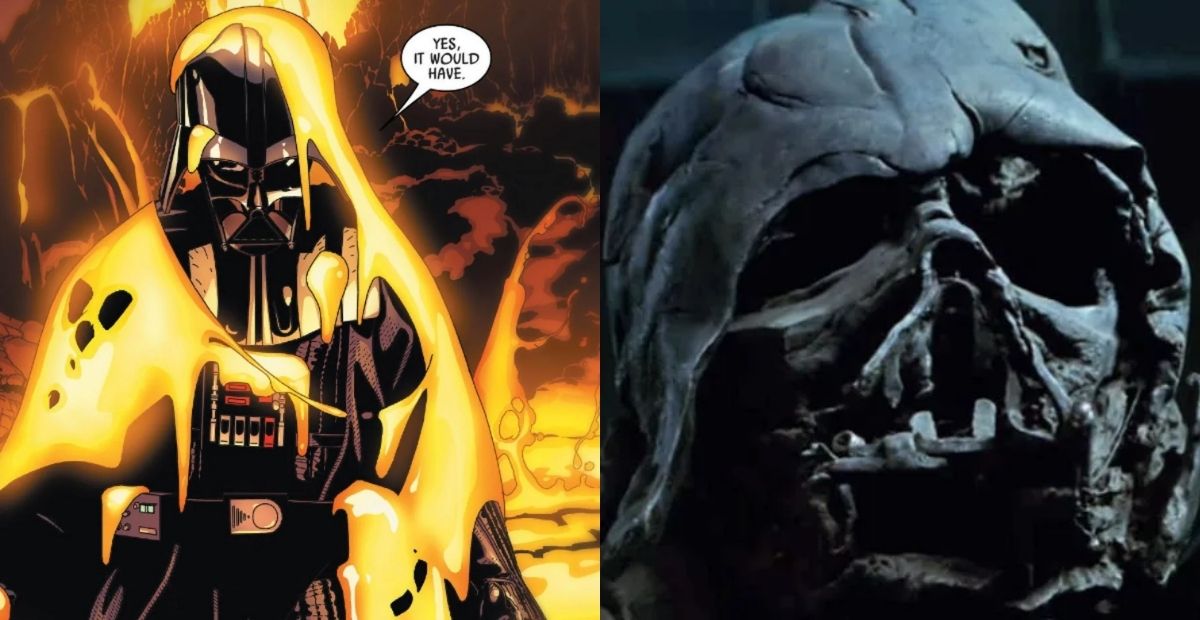In The Force Awakens, there’s this intense scene where Kylo Ren is speaking to the melted mask of Darth Vader. It got me thinking – how did the mask end up like that?
After all, in some of the Star Wars comics, we see Vader standing in molten material, and his suit doesn’t seem to take any damage.
So, why does the mask look so destroyed in the movie, but stays intact in other parts of the Star Wars universe?
This question has been on my mind, and I’m sure there are others wondering about it too.
Therefore, in this article, I’m going to get into how Darth Vader’s mask could have melted after Return of the Jedi, even though his suit is said to be lava-resistant.
1. The Dream Sequence Confusion
First things first: if you’ve seen images of Vader’s melted mask from the Darth Vader (2015) comic issue #24, it’s important to know that the scene often comes from a dream sequence.
In this scene, Vader imagines winning the battle on Mustafar against Obi-Wan Kenobi, which, of course, didn’t actually happen.
So, when you see his mask melting or getting destroyed in this context, it’s not a contradiction to what’s established about his suit’s durability – it’s just not real.
This “dream sequence” explanation clears up a lot of confusion because it separates what happens in Vader’s mind from what’s happening in the physical world.
But what could be explained more about the melted mask we see later on in The Force Awakens?
2. The Funeral Pyre: Long Exposure to Fire
The real-world explanation for Vader’s melted helmet comes down to the funeral pyre that Luke Skywalker built on Endor.
Now, Vader’s suit may be resistant to short bursts of extreme heat like lava, but prolonged exposure to fire is a different story.
Lava, after all, can peak around 1,600°F, but a wood-fueled fire, like a funeral pyre, can reach temperatures between 1,000°F and 2,000°F.
That’s plenty hot enough to eventually melt or deform metal. Think about it: Vader’s helmet was left burning for an extended period.
While the suit was designed to handle extreme environments, it wasn’t built to withstand a fire slowly burning away at it for hours.
Over time, the intense heat would have damaged the helmet’s outer layers, leading to its melted appearance.
3. Vader’s Suit: Resistant, But Not Indestructible
Yes, Vader’s suit is incredibly durable and offers protection against a lot of extreme conditions, including the heat of Mustafar’s lava.
But it’s not indestructible. His suit was designed to keep him alive and functioning, not to be impervious to every possible threat.
While it can handle brief exposure to extreme heat or flames, it’s not immune to long-term damage, especially when left in something like a burning pyre.
This brings us to an important point: the difference between “lava-proof” and “fire-resistant.” Vader’s suit could resist the heat of Mustafar because it wasn’t directly submerged in the lava for long periods.
In contrast, sitting in a pyre for hours gave the fire more than enough time to break down the materials of his suit, especially in areas like the mask, which may be more vulnerable.
Another example proving that Darth Vader’s mask is not indestructible occurs when it is partially destroyed by the intense heat of Ahsoka’s lightsaber, which reaches a staggering 36,500°F.
4. Palpatine’s Force Lightning: A Possible Complication
There’s also the matter of Palpatine’s force lightning in Return of the Jedi.
Vader endured a significant amount of lightning while saving Luke, and it’s possible that this damaged some of the suit’s protective functions.
Force lightning is known to wreak havoc on electronics, and since Vader’s suit has advanced systems to keep him alive, it’s not a stretch to imagine that this attack could have weakened those systems, including the helmet’s ability to resist heat.
So, by the time Vader was placed on the pyre, his suit wasn’t at its best.
The combination of the lightning damage and the sustained heat from the fire might have been enough to cause the mask to melt more easily than it would have otherwise.
Last Words
In short, Vader’s mask could melt after the end of Return of the Jedi due to a combination of factors.
The long exposure to fire from the funeral pyre, potential damage from Palpatine’s force lightning, and the limitations of his suit’s resistance all play a role in the mask’s destruction.
While his suit may have been lava-resistant, it wasn’t invincible, especially under these circumstances.
So, while the melted mask might seem like a mystery at first glance, the more you dig into the details, whether it’s a dream sequence or the result of a prolonged fire, there’s enough here to explain why Vader’s iconic helmet ends up looking so different by the time we see it again in The Force Awakens.

